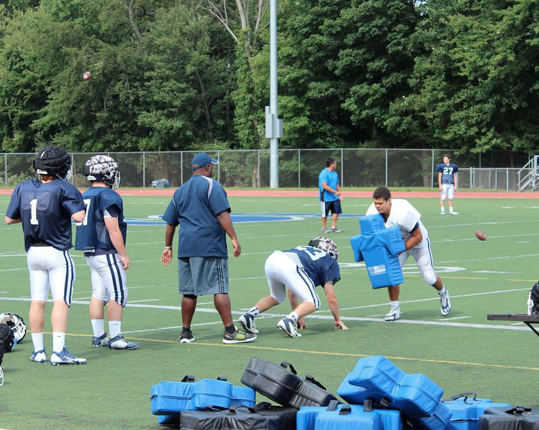Teams gear up for season with conditioning
A bead of sweat trickles down his face and plunges to the sand below. A drop quivers and falls from her forehead to the hardwood floor of the gym. His drenched hair bounces as he runs, spraying sweat everywhere like a wet dog.
Even though each sport at Staples is different, they all have one thing in common, conditioning. Season in and season out, Staples athletes find themselves striving and sweating to get stronger.
Emily Lustbader ’16, who plays both varsity softball and varsity girls’ volleyball, notes the differences in the training. She found that softball has more running and standard workouts, while volleyball has “seven minute circuits that include workouts for a lot of the muscle groups that are particularly important for volleyball,” with a focus on the core and the upper body.
For single-sport athletes, like varsity boys’ soccer captain Patrick Beusse ’15 and rugby player Aidan Clarke ’15, conditioning requires off-season workouts in addition to those during the season.
Soccer has two early morning practices a week from January until June. Throughout the summer the soccer players do extremely challenging workouts on the beach, which consist of sprints up a hill, running the full length of the beach, and basic upper body and core work.
“Conditioning [makes us] a much stronger and better prepared team, which helps us out-work and out-muscle other teams,” Beusse said.
As for Clarke, the rugby preseason workouts consist of basic strength work like fireman carries and push ups. During the season, all of the workouts are rugby oriented, with sprint-and-tackle drills and other agility work. Like Beusse, Clarke finds that the work is very beneficial.
“The conditioning we do for rugby is spot on,” Clarke said. “In rugby you have to constantly be moving. And with only eight subs you have to be ready to play the full 80 minutes.”
There is one sport that seems to have an even tougher regimen than rugby and soccer.
The Staples football team is the pinnacle of off-season conditioning with a rigorous year-round training schedule. Besides the usual practices during the season, it is expected that unless a player plays another sport in addition to football, he is in the weight-room three days a week after school, all through the winter and into the spring.
This past year, Coach Marce Petroccio implemented a new workout schedule for the summer, with four-day-a-week workouts running from 6:30 a.m. until 8 a.m.
“With workouts that early, we figure out pretty quickly how badly you want to play football,” Petroccio said.
In addition to the obvious benefits of improved strength and stamina, Petroccio has two other important reasons for the demanding schedule. The first is safety.
“I’ve been to Boston College and [the University of Connecticut], and spoken to their head trainers, and what I’ve learned is that the better shape these kids are in and the more they build up their neck muscles, there is a lower risk for concussions, as well as any other injury,” Petroccio said.
The other reason is all about camaraderie.
“When you’re in that weight room that often with the same guys, it definitely builds a strong sense of team chemistry,” Petroccio said.

Jimmy Ray Stagg is a Staples senior and has been an Inklings writer since sophomore
year. He likes to cover sports and plays baseball and football in...
















































